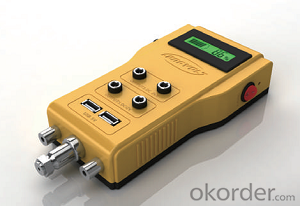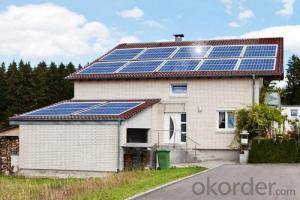Split-type Solar Home Energy Storage System
- Loading Port:
- Shanghai
- Payment Terms:
- TT OR LC
- Min Order Qty:
- 1 set
- Supply Capability:
- 500 set/month
OKorder Service Pledge
OKorder Financial Service
You Might Also Like
Item specifice
1. Descriptions of Split-type Solar Home Energy Storage System
- Split-type solar home energy storage system is a collection of lithium-ion battery packs, intelligent controllers and output control of household energy storage control system,Has the advantages of high energy density, long cycle life, good temperature characteristics, excellent safety performance
- Output panel can read the battery capacity and voltage at any time, a key control is simple and convenient, double protection and application of high security, Three sets of voltage stable output, suitable for a variety of low-voltage electrical appliances, low-voltage output more secure, compact and easy to install
2. Component of the split-type solar home energy storage system
- Solar panels spring
-Split-type home energy storage system
-Output control panel
3. Technical Parameter Split-type Solar Home Energy Storage System
| Model | LVSS-FJY03600 | LVSS-FJY07200 | LVSS-FJY12000 | LVSS-FJY16800 | LVSS-FJY24000 | |
| Load | Power | 15W | 30W | 50W | 70W | 100W |
| Description | Light bulb/ Fan/ DVD | Light bulb+Fan/ Light bulb+DVD/ Light bulb+DVD | TV set Set-top boxes | TV set+Set-top boxes Light bulb+Fan/ Light bulb+DVD/ Light bulb+DVD | TV set +Set-top boxes +light bulb +Car refrigerator | |
| Solar panel | Power | 90Wp | 180Wp | 300Wp | 450Wp | 640Wp |
| Lithium battery system | Capacity | 360Wh | 720Wh | 1200Wh | 1680Wh | 2400Wh |
| Continuous working time | 24H | |||||
| Working temperature | -50°C - 55°C | |||||
| Warranty | 3 years | |||||
4. Image

5. FAQ
- Package?
Carton, Transported by sea.
- Q:Can solar energy systems be used for desalination or water purification?
- Yes, solar energy systems can definitely be used for desalination or water purification. Solar energy can power various technologies that are employed in the process of desalination and water purification, making it a sustainable and renewable source of energy for these purposes. One of the most common methods of desalination is through the use of solar stills. Solar stills are devices that use the energy from the sun to evaporate water, leaving behind salts, impurities, and contaminants. The steam is then condensed and collected, providing fresh water that is free from salinity and impurities. Solar stills are particularly effective in areas where there is ample sunlight and limited access to freshwater sources. Another method is solar-powered reverse osmosis. Reverse osmosis is a process that uses a membrane to remove salts, impurities, and contaminants from water at high pressure. By utilizing solar energy to power the high-pressure pump, this method can effectively produce fresh water from seawater or brackish water sources. Additionally, solar energy can also be used in combination with other water treatment technologies such as ultraviolet (UV) disinfection and advanced filtration systems. UV disinfection uses the energy from ultraviolet light to kill bacteria, viruses, and other microorganisms present in water. Solar-powered UV disinfection systems are not only environmentally friendly but also cost-effective in areas where electricity supply is limited. In summary, solar energy systems can be harnessed to power various desalination and water purification technologies, providing a sustainable and renewable solution to address water scarcity and improve access to clean water.
- Q:Can solar energy systems be used in powering construction sites or temporary structures?
- Yes, solar energy systems can definitely be used to power construction sites or temporary structures. In fact, solar power is increasingly being utilized in these scenarios due to its numerous advantages. Firstly, construction sites often lack access to traditional power sources, which makes solar energy a practical solution. Solar panels can be easily installed on rooftops, scaffolding, or even on the ground, providing a reliable source of electricity throughout the construction process. Secondly, solar energy systems offer flexibility in terms of power generation. They can be customized to meet specific energy demands of construction sites, whether it is for running power tools, lighting, or charging equipment. This adaptability ensures that construction activities can proceed smoothly without interruptions. Additionally, solar energy systems are environmentally friendly. By harnessing energy from the sun, construction sites can significantly reduce their carbon footprint and contribute to sustainable practices. Solar power does not produce harmful emissions or noise pollution, which is particularly beneficial in urban areas or sensitive environments. Furthermore, solar energy systems offer cost savings in the long run. While the initial investment for installing solar panels might be higher compared to traditional generators, the ongoing operational costs are significantly lower. Construction sites can benefit from reduced fuel expenses, maintenance costs, and reliance on fossil fuels. It is worth mentioning that solar energy systems can also be used for temporary structures such as mobile offices, portable restrooms, or event venues. These structures can be easily powered using solar panels, eliminating the need for generators or grid connections. In conclusion, solar energy systems are a viable and sustainable option for powering construction sites and temporary structures. They provide reliable, customizable, and cost-effective power solutions while minimizing environmental impact. As the global shift towards renewable energy continues, solar power will likely become even more prevalent in construction industry practices.
- Q:Can solar panels be installed on different surfaces like glass or metal?
- Yes, solar panels can be installed on different surfaces like glass or metal. In fact, solar panels are commonly installed on rooftops, which are often made of materials like glass, metal, or asphalt shingles. The most common type of solar panels, known as photovoltaic (PV) panels, are designed to be mounted on a variety of surfaces. The installation process involves securing the panels to the surface using racks or frames, ensuring that they are properly angled to maximize sunlight exposure. Whether it is a glass or metal surface, solar panels can be installed and effectively generate electricity from the sun's energy.
- Q:Can solar energy systems be used for recreational vehicles or boats?
- Yes, solar energy systems can be used for recreational vehicles or boats. These systems can provide power for various appliances and electronics, making them suitable for off-grid camping or sailing. Solar panels can be installed on the roof or deck of the vehicle or boat, and the energy generated can be stored in batteries for later use. This allows for a sustainable and convenient power source while enjoying outdoor activities.
- Q:Can solar energy systems be used for powering refrigeration systems?
- Yes, solar energy systems can be used for powering refrigeration systems. Solar-powered refrigeration systems, known as solar refrigerators or solar coolers, use photovoltaic panels to convert sunlight into electricity which can be used to power the refrigeration process. These systems are commonly used in off-grid areas or remote locations where access to electricity is limited or expensive. They offer a sustainable and environmentally friendly solution for refrigeration needs.
- Q:Can solar energy systems be used for powering water pumping systems?
- Yes, solar energy systems can be used for powering water pumping systems. Solar-powered water pumping systems use photovoltaic (PV) cells to convert sunlight into electricity, which can then be used to power water pumps. This provides a sustainable and cost-effective solution for pumping water in remote areas or locations without access to electricity grids.
- Q:Do solar energy systems require regular inspections?
- Yes, solar energy systems do require regular inspections to ensure their proper functioning and efficiency. Regular inspections help identify any potential issues, such as damage, malfunctioning components, or reduced energy production, which can be addressed and resolved promptly to maintain the system's performance and longevity.
- Q:Can solar energy systems be used in areas with high levels of seismic activity?
- Yes, solar energy systems can be used in areas with high levels of seismic activity. However, it is important to design and install these systems with proper engineering considerations and precautions to withstand potential earthquakes. By implementing robust mounting structures, flexible connections, and secure anchoring systems, solar panels can be made resilient to seismic forces. Additionally, regular inspections and maintenance should be carried out to ensure the integrity and safety of the solar energy systems in earthquake-prone areas.
- Q:What are the components of the solar photovoltaic system?
- EVA: a high quality EVA film with a thickness of 0.78mm, which is made of UV resistant agent, antioxidant and curing agent, is used as a sealing agent for solar cells and a bonding agent between glass and TPT. High light transmittance and aging resistance.
- Q:How do solar energy systems connect to the electrical grid?
- Solar energy systems can connect to the electrical grid by means of net metering, a process that enables the system to generate and consume electricity from the grid. Excess power generated by the solar energy system is sent back to the grid and measured by a bi-directional meter, which calculates the flow of electricity in both directions. This surplus electricity is then credited to the system owner's account, effectively reversing the meter. Conversely, during times when the solar energy system is unable to meet the electricity demand, such as at night or on cloudy days, electricity is drawn from the grid to make up for the shortfall. The bi-directional meter accurately records this flow of electricity and measures the amount consumed from the grid. In summary, the connection between solar energy systems and the electrical grid facilitates the seamless integration of renewable energy into the existing power infrastructure. Net metering ensures that solar system owners can contribute excess electricity to the grid and draw from it when needed, resulting in a more efficient, reliable, and sustainable energy system.
1. Manufacturer Overview |
|
|---|---|
| Location | |
| Year Established | |
| Annual Output Value | |
| Main Markets | |
| Company Certifications | |
2. Manufacturer Certificates |
|
|---|---|
| a) Certification Name | |
| Range | |
| Reference | |
| Validity Period | |
3. Manufacturer Capability |
|
|---|---|
| a)Trade Capacity | |
| Nearest Port | |
| Export Percentage | |
| No.of Employees in Trade Department | |
| Language Spoken: | |
| b)Factory Information | |
| Factory Size: | |
| No. of Production Lines | |
| Contract Manufacturing | |
| Product Price Range | |
Send your message to us
Split-type Solar Home Energy Storage System
- Loading Port:
- Shanghai
- Payment Terms:
- TT OR LC
- Min Order Qty:
- 1 set
- Supply Capability:
- 500 set/month
OKorder Service Pledge
OKorder Financial Service
Similar products
New products
Hot products
Hot Searches
Related keywords





























